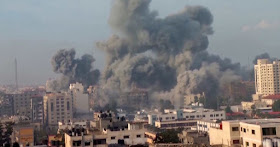Israel’s 19-day bombing campaign in Gaza has become one of the most intense of the 21st century, prompting growing global scrutiny of its scale, purpose and cost to human life.Since terrorists from Gaza raided Israel on Oct. 7, killing roughly 1,400 people according to the Israeli government, the Israeli military says it has struck more than 7,000 targets inside Gaza. That is a higher number than in any previous Israeli military campaign in the territory, a narrow enclave less than half the size of New York City. It also outstrips the most intense month of the United States-led bombing campaign against ISIS, according to Airwars, a British conflict monitor.
7,000 is indeed a high number. But in the same time period, Gaza groups have shot some 7,500 rockets at Israel - an even higher number.
The story doesn't mention that.
On the contrary; it tries to minimize the rocket threat:
The strikes appear to have successfully curbed the groups’ rocket-firing abilities. The Israeli military has not released exact numbers, but there were fewer than 20 air raid sirens across Israel on Wednesday, compared with hundreds during the first days of the war.
No big deal. Rockets towards Eilat, Tel Aviv and Haifa in the past day? It was less than 20! Just because a million people had to run to shelter on that day, so what? Sounds pretty tolerable!
But this part of the article is worse:
Even as Israel has used precision weapons, it has maintained a broad definition of what constitutes a military target. Fighter jets wrecked the Islamic University in Gaza because Israel said the campus had been used to train intelligence operatives. They have targeted mosques that Israel says served as weapons depots and operation centers. And they have targeted Hamas commanders in their homes.
This is not a broad definition. This is part of the definition.
Although Israel has not signed this protocol, it accepts the definition under Article 52(2) Additional Protocol I of the Geneva Conventions, which says:
Insofar as objects are concerned, military objectives are limited to those objects which, by their nature, location, purpose or use make an effective contribution to military action and whose total or partial destruction, capture or neutralization, in the circumstances ruling at the time, offers a definite military advantage.
Hamas has used the Islamic University of Gaza not only for military training but also for weapons development and production, as Israel said at the time of the airstrike: "The university was being used as a Hamas training camp for military intelligence operatives, as well as for the development and production of weapons." That makes it unambiguously a military target. (And the university is known for being a Hamas stronghold: it was used for storing weapons, for holding hostages, for planning attacks and for acting as a safehouse for terrorists as well as for weapons development.)
Weapons depots and operations centers are also military targets by any definition of the term, whether they are in a mosque or a medical clinic or a school. They lose all civilian protections.
Military leaders are still legitimate targets, even if they are using their own families as human shields.
Using civilian areas for military purposes is a war crime. That isn't mentioned in the NYT - on the contrary, it casts aspersions on whether Israel can really attack military objects disguised as civilian.
It is an advertisement for using human shields.
|
Or order from your favorite bookseller, using ISBN 9798985708424. Read all about it here! |

|


